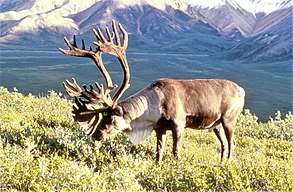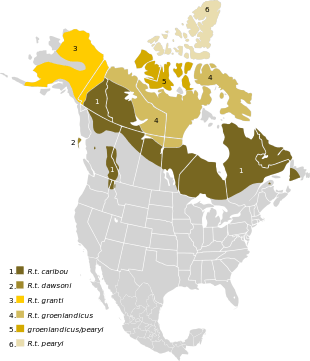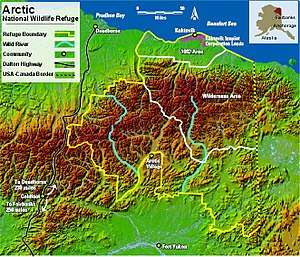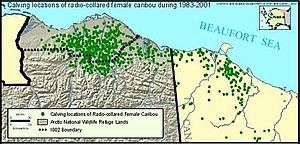Porcupine caribou
The Porcupine caribou or Grant's caribou (Rangifer tarandus granti) is a subspecies of the reindeer (or the caribou in North America) found in Alaska, United States, and adjacent parts of Canada. It resembles the subspecies known as the barren-ground caribou (R. t. groenlandicus) and is sometimes included in it.
| Porcupine caribou | |
|---|---|
 | |
| Male Porcupine caribou (R. t. granti) grazing in Alaska | |
| Scientific classification | |
| Kingdom: | Animalia |
| Phylum: | Chordata |
| Class: | Mammalia |
| Order: | Artiodactyla |
| Family: | Cervidae |
| Subfamily: | Capreolinae |
| Genus: | Rangifer |
| Species: | |
| Subspecies: | R. t. granti |
| Trinomial name | |
| Rangifer tarandus granti Allen, 1902 | |
 | |
| Approximate range of Porcupine caribou in yellow. Overlap with other subspecies of caribou is possible for contiguous range. 1. Woodland caribou (Rangifer tarandus caribou), which is subdivided into ecotypes: boreal, migratory and mountain, 2. R. t. dawsoni (extinct 1908), 3. R. t. granti, 4. R. t. groenlandicus, 5. R. t. groenlandicus/pearyi, 6. R. t. pearyi | |
Migratory caribou herds are named after their birthing grounds, in this case the Porcupine River, which runs through a large part of the range of the Porcupine herd. Though numbers fluctuate, the herd comprises about 218,000 animals (based on a July 2017 photocensus).[1] They migrate over 1,500 mi (2,400 km) a year between their winter range and calving grounds at the Beaufort Sea, the longest land migration route of any land mammal on Earth. Their range spans the Alaska/Yukon border and is a valued resource cooperatively managed by the Alaska Department of Fish and Game, Canadian wildlife agencies and local aboriginal peoples. The caribou are the primary sustenance of the Gwichʼin, a First Nations/Alaska Native people, who traditionally built their communities to align with the caribou's migration patterns. They are also routinely hunted by other indigenous peoples, including the Inupiat, the Inuvialuit, the Hän and the Northern Tutchone.
By July 2017, the Porcupine herd had reached a record high of about 202,000 to 235,000 animals. Sixteen years earlier, in 2001 the same herd was only half as large. While other barren-ground caribou herds have declined by 90%, the Porcupine herd has remained relatively stable.
Taxonomy
The Porcupine caribou, also known as Grant's caribou (Rangifer tarandus granti), is a subspecies of the caribou found in Alaska, United States and adjacent parts of Canada. It is sometimes included in the subspecies called the barren-ground caribou (R. t. groenlandicus), which it resembles.[2][3]
Range

The Porcupine herd range covers 1,500 mi (2,400 km) migrating annually from the calving grounds and birthing grounds, the Porcupine River after which they are named, to "the river valleys and slopes in the Ogilvie and Richardson Mountains in the Yukon and the southern Brooks Range in Alaska in the winter.[4]:3 The calving area is located on 1.5 million acres (0.61 million ha) in the Porcupine River coastal region of the Beaufort Sea known as the 1002 area, which is part of the Arctic National Wildlife Refuge.[5] The area runs through a large part of the range of the Porcupine herd.[1][6]
In the spring the pregnant cows move "northeast from the Alaskan winter ranges or north and northwest from the Canadian winter ranges. If snowmelt is early, they will then move westward along the north slope of the Brooks Range into Alaska."[4]:3

Most Porcupine caribou calves are born in the first week of June and they are at their most vulnerable from their primary predators on the calving ground - golden eagles, grizzly bears and wolves - during the first three weeks when they are dependent on milk from their mothers. About one quarter of them die during this period.[4]:5,6 Their 1,500 miles (2,400 km) annual land migration between their winter range in the boreal forests of Alaska and northwest Canada over the mountains to the coastal plain and their calving grounds on the Beaufort Sea coastal plain,[5] is the longest of any land mammal on earth.
Management
The Alaska Department of Fish and Game, Canadian wildlife agencies, and local aboriginal peoples cooperatively manage the Porcupine herd. The Porcupine Caribou Management Board (PCMB) advisory board was established under the Porcupine Caribou Management Agreement in 1985, whose members include representatives from the Gwich'in Tribal Council, Na-cho Nyäk Dün, Vuntut Gwitchin, Government of Yukon, Tr'ondëk Hwëch'in, Inuvialuit Game Council, and the Government of Canada.[7] The PCMB publish an annual Porcupine Caribou Harvest Report.[8] In their February 2018 report they recorded that a 2017 photocensus (survey) estimated a mean of 218,457 caribou (95% CI = 202,106 to 234,808) caribou, indicative of an increasing trend from 2010 to 2017, from 169,000 to about 218,000.[8]:2 On July 17, 1987, the United States and the Canadian government signed the "Agreement on the Conservation of the Porcupine Caribou Herd" a treaty designed to protect the subspecies from damage to its habitat and migration routes.[9][10] Both the Ivvavik National Park and Vuntut National Park border the ANWR. The treaty required an impact assessment and required that where activity in one country is "likely to cause significant long-term adverse impact on the Porcupine Caribou Herd or its habitat, the other Party will be notified and given an opportunity to consult prior to final decision".[10] This focus on the Porcupine caribou led to the animal becoming a visual rhetoric or symbol of the drilling issue much in the same way the polar bear has become the symbol of global warming.[11]
Potential threats to the Porcupine herd
Climate change and the increased frequency of extreme weather events, such as unprecedented late slow melting, negatively affect the Porcupine herd. As a result there was "very high early calf mortality."[4]:10 The primary predators for calves are golden eagles, grizzly bears and wolves.[4] "Caribou exposed to industrial development shift away from the pipelines and roads."[4]:12 The passage of the provision opening ANWR's 1002 to oil and gas drilling is considered to be a threat.[5] In 2001, some biologists feared development in the Refuge would "push caribou into the foothills, where calves would be more prone to predation."[5] In their 2005 report, Russell and McNeil reiterated concerns that new calving areas would make the herd more vulnerable, as area 1002 provides a much higher quality of diet conditions than the alternatives in Canada.[4]
Indigenous peoples
The Porcupine caribou are a valued resource as primary sustenance to indigenous peoples in Alaska and northern Canada. Gwichʼin, a First Nations/Alaska Native people traditionally built their communities to align with the caribou's migration patterns. The Inupiat, the Inuvialuit, the Hän and the Northern Tutchone also hunt caribou from this herd on a regular basis.
Arctic National Wildlife Refuge

The Arctic National Wildlife Refuge (ANWR) covers 19 million acres (7.7 million ha) of the northern Alaskan coast,[12] in northeast Alaska[5] between the Beaufort Sea to the north, Brooks Range to the south and Prudhoe Bay to the west. It is the largest protected wilderness in the United States and was created by Congress under the Alaska National Interest Lands Conservation Act of 1980.[13]

On December 22, 2017, President Donald Trump signed the Tax Cuts and Jobs Act of 2017, a provision that opened the 1002 area of ANWR to oil and gas drilling, into law. The Act contains provisions that would open 1.5 million acres in the Arctic National Wildlife Refuge to oil and gas drilling.[14][15] Opening the Arctic Refuge to drilling "unleashed a torrent of opposition from conservationists and scientists."[16] Democrats[17][18] and environmentalist groups such as the Wilderness Society criticized the Republican effort.[18] Since 1977 area 1002, which encompasses much of the Porcupine caribou calving grounds, has been a topic of controversy.[19] The 1,500,000 acres (6,100 km2) subsection on the coastal plain, known as the "1002 area"[20] is located between the Brooks Range and the Beaufort Sea. The plain "stretches west from the Yukon border more than a hundred miles, a flat expanse of tundra laced with tussock wetlands and braided rivers."[5]
Herd size
"We might have just recorded [July 2017] the largest number for this herd since modern scientific monitoring started in the 1970s... Given the state of caribou worldwide right now, it's a positive, shining light in the caribou world — that there are some herds that are doing well."
— Mike Suitor, regional biologist, North Yukon Region with Environment Yukon, Dawson City. 2018. CBC News
Unlike many other Rangifer tarandus subspecies and their ecotypes, the Porcupine herd is stable at relatively high numbers. Some barren-ground caribou herds have "declined more than 90 per cent from historic averages", causing the Committee on the Status of Endangered Wildlife in Canada (COSEWIC), to sound the alarm.[21]
According to an aerial count reported in July 2017, the size of the Porcupine herd had increased to "between 202,000 and 235,000 animals, nearly twice the number of animals recorded at a low point in 2001.[21]
A previous peak population occurred in 1989 with 178,000 animals and was followed by a decline by 2001 to 123,000. A recovery was observed in 2010 with an increase to 169,000 animals.[1][6]
Ivvavik National Park
Ivvavik National Park protects a portion of the calving grounds of the Porcupine herd and restricts the number of people who may visit annually. During the calving in May, caribou are at their most vulnerable. Caribou management calls for preservation of calving grounds. Large portions of the calving grounds have been protected in the Arctic National Wildlife Refuge in Alaska, United States and Ivvavik National Park and Vuntut National Park in Canada.[22]
Central Arctic caribou herd
In 2001, proponents of the development of the oil fields at Prudhoe Bay and Kuparuk, which would be approximately 60 miles (97 km) west of the refuge, argued that the Central Arctic caribou herd had increased its numbers "in spite of several hundred miles of gravel roads and more than a thousand miles of elevated pipe." However, the Central Arctic herd is much smaller than the Porcupine herd and has a range that is much larger.
The 1002 coastal plain provides calving habitat for [the Porcupine herd] nearly five times as large as the central Arctic herd, in an area one-fifth as big. Some biologists fear development here could push caribou into the foothills, where calves would be more prone to predation
— Mitchell National Geographic 2001[5]
References
- Campbell, Cora (2 March 2011), Porcupine Caribou Herd shows growth, Press release, Juneau, Alaska: Alaska Department of Fish and Game, retrieved 27 January 2014
- Grubb, P. (2005). Wilson, D.E.; Reeder, D.M. (eds.). Mammal Species of the World: A Taxonomic and Geographic Reference (3rd ed.). Johns Hopkins University Press. ISBN 978-0-8018-8221-0. OCLC 62265494.
- Cronin, Matthew A.; Macneil, Michael D.; Patton, John C. (2005). "Variation in Mitochondrial DNA and Microsatellite DNA in Caribou (Rangifer tarandus) in North America". Journal of Mammalogy. 86 (3): 495–505. doi:10.1644/1545-1542(2005)86[495:VIMDAM]2.0.CO;2.
- Russell, Don E.; McNeil, P. (March 2005). Summer Ecology of the Porcupine Caribou Herd (PDF) (Report) (2 ed.). Whitehorse, Yukon: Porcupine Caribou Management Board (PCMB). p. 14. This report includes detailed maps of the region.
- Mitchell, John (August 1, 2001). "Oil Field or Sanctuary?"". National Geographic. Retrieved March 21, 2018.
- Kolpashikov, L.; Makhailov, V.; Russell, D. (2014). "The role of harvest, predators and socio-political environment in the dynamics of the Taimyr wild reindeer herd with some lessons for North America". Ecology and Society. 20. doi:10.5751/ES-07129-200109.
- "About". Porcupine Caribou Management Board (PCMB). Whitehorse, Yukon.
- "Porcupine Caribou Harvest Management Plan Annual Harvest Meeting 2018" (PDF). Dawson City, Yukon. February 14, 2018.
- "Agreement Between the Government of the United States and the government of Canada on the Conservation of the Porcupine Caribou Herd" (PDF). New York. 1987.
- United Nations. Agreement Between the Government of the United States and the government of Canada on the Conservation of the Porcupine Caribou Herd New York: UNU. 1987.
- "Cox, R. Environmental Communication and the Public Sphere, 2013, Sage Publications"
- Burger, Joel. "Adequate science: Alaska's Arctic refuge". Conservation Biology 15 (2): 539.
- United States. 96th Congress. "Alaska National Interest Lands Conservation Act". Fws.gov <"Archived copy". Archived from the original on 2008-08-28. Retrieved 2008-08-28.CS1 maint: archived copy as title (link)>. Retrieved on 2008-8-10.
- Shankman, Sabrina (December 2, 2017). "12 House Republicans Urge Congress to Cut ANWR Oil Drilling from Tax Bill". InsideClimate News.
- Natter, Ari; Dlouhy, Jennifer A. (2017-12-19). "Tax Bill Opens Arctic Refuge for Oil, But Years of Delay May Follow". Bloomberg L.P. Retrieved 2017-12-20.
- Shankman, Sabrina (November 16, 2017). "At Stake in Arctic Refuge Drilling Vote: Money, Wilderness and a Way of Life". InsideClimate News.
- Scott Detrow, Senate May Approve Drilling In Alaskan Wilderness With Tax Bill, NPR (November 18, 2017).
- Solomon, Christopher (November 16, 2017). "The ANWR Drilling Rights in the Tax-Reform Bill". Outside.
- Shogren, Elizabeth (November 10, 2005). "For 30 Years, a Political Battle Over Oil and ANWR". NPR. All Things Considered. Retrieved March 21, 2018.
- "Potential Oil Production from the Coastal Plain of the Arctic National Wildlife Refuge: Updated Assessment". US DOE. Archived from the original on 3 April 2009. Retrieved 2009-03-14.
- Morin, Philippe (January 4, 2018). "Porcupine caribou numbers 'highest ever recorded'". CBC News. Retrieved March 21, 2018.
'It's a positive, shining light in the caribou world,' says Yukon biologist
- Smithson, Brandi; Jjumba, Anthony (2006), "Threats to the Porcupine Caribou Herd", Simon Fraser University (SFU), Atlas of the Porcupine Caribou, retrieved March 21, 2018